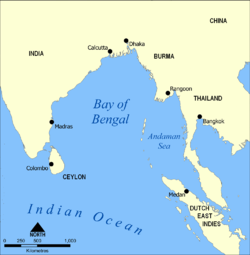| Action of 9 September 1796 | |||||||
|---|---|---|---|---|---|---|---|
| Part of the French Revolutionary Wars | |||||||
Map of East Indies. Site of battle marked in red | |||||||
| |||||||
| Belligerents | |||||||
|
|
| ||||||
| Commanders and leaders | |||||||
| Pierre César Charles de Sercey | Richard Lucas | ||||||
| Strength | |||||||
| 6 frigates | 2 ships of the line | ||||||
| Casualties and losses | |||||||
|
42 killed 104 wounded |
24 killed 84 wounded | ||||||
The action of 9 September 1796 was an inconclusive minor naval engagement between small French Navy and British Royal Navy squadrons off northwestern Sumatra, near Banda Aceh, during the French Revolutionary Wars. The French squadron comprised six frigates engaged in commerce raiding against British trade routes passing through captured parts of the Dutch East Indies, and posed a considerable threat to the weakened British naval forces in the region. The British force consisted of two 74-gun ships of the line hastily paired to oppose the eastward advance of the French squadron.
The French squadron, commanded by Contre-amiral Pierre César Charles de Sercey, had left its base on Île de France in July and cruised off Ceylon and Tranquebar before sailing eastwards. Its movement had so far been unopposed, as British forces in the East Indies were concentrated at Simon's Town in the west and Malacca in the east. After raiding the shipping at Banda Aceh on 1 September the squadron sailed eastwards to attack Penang. On 8 September, while the French were removing supplies from a captured British merchant ship east of Banda Aceh, two large sails were spotted. These were HMS Arrogant and HMS Victorious, sent to drive off the French before they could attack the scattered British shipping and ports in the region.
Although the British ships were substantially larger than any individual French vessel, the frigates were more numerous and more manoeuvrable. Neither side could afford to take significant damage in the battle, so each sought to drive the other off rather than achieve an outright victory. On 9 September Sercey's frigates formed a line of battle, successfully engaging first Arrogant and then Victorious and inflicting damage on each while preventing them from supporting one another. The French frigates, particularly Vertu and Seine, also suffered, and by late morning both sides disengaged, the British retiring to Madras for repairs, while Sercey anchored at King's Island in the Mergui Archipelago, eventually sheltering in Batavia.
